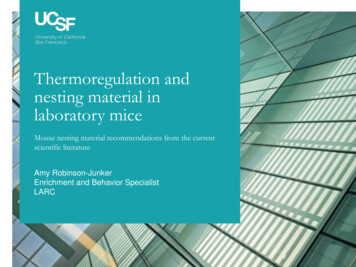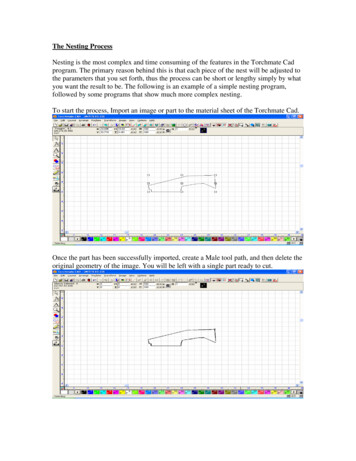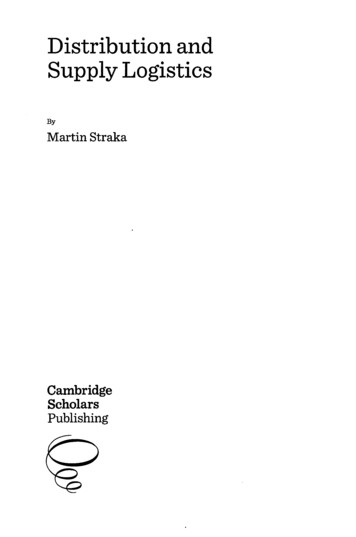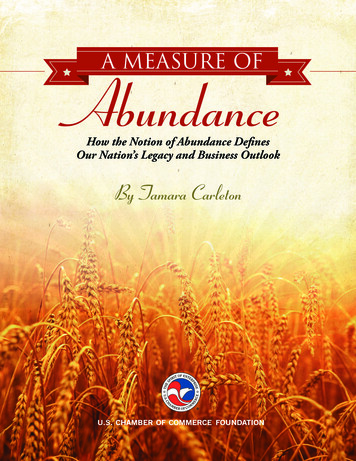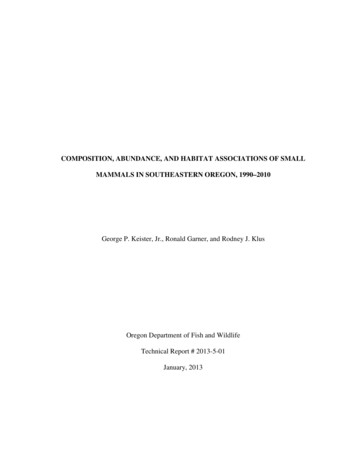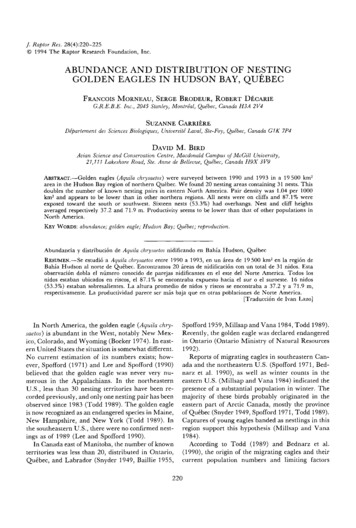
Transcription
j. Raptor Res. 28(4):220-225 1994 The Raptor ResearchFoundation, Inc.ABUNDANCEANDDISTRIBUTIONOFNESTINGGOLDEN EAGLESIN HUDSON BAY,QUIBECFRANGOISMORNEAU, SERGEBRODEUR,ROBERT DgGARIEG.R.E.B.E. Inc., 20d5 Stanley,Montreal,Quebec,CanadaH3A 2VdSUZANNE CARRIgRED partementdesSciencesBiologiques,UniversitdLaval, Ste-Foy,Quebec,CanadaGIK 7PdDAVIDM.BIRDArian Scienceand ConservationCentre,MacdonaldCampusof McGill Qugbec,CanadaH9X 3V9ABSTR CT.--Goldeneagles(Aquilachrysaetos)were surveyedbetween1990 and 1993 in a 19 500 km2area in the HudsonBay regionof northernQu6bec.We found20 nestingareascontaining31 nests.Thisdoublesthe number of known nestingpairs in easternNorth America. Pair densitywas 1.04 per 1000km2 and appearsto be lower than in other northern regions.All nestswere on cliffs and 87.1% wereexposedtoward the south or southwest.Sixteennests(53.3%) had overhangs.Nest and cliff heightsaveragedrespectively37.2 and 71.9 m. Productivityseemsto be lower than that of other populationsinNorthAmerica.KEY WORDS:abundance;goldeneagle;HudsonBay; Qugbec;reproduction.Abundanciay distribuci6nde Aquilachrysaetosnidificandoen Bahia Hudson,QuebecRESUMEN.--Seestudi6a Aquilachrysaetosentre 1990 a 1993, en un itreade 19 500 km2 en la regi6ndeBahiaHudsonal nortede Qu6bec.Encontramos20 ireas de nidificaci6nconun total de 31 nidos.Estaobservaci6ndobla el nfimero conocidode parejasnidificantesen el estedel Norte America. Todos losnidos estabanubicadosen riscos,el 87.1% se encontrabaexpuestohacia el sur o el suroeste.16 nidos(53.3%) estabansobresalientes.La altura promediode nidosy riscosse encontrabaa 37.2 y a 71.9 m,respectivamente.La productividadpareceser mits baja queen otraspoblacionesde Norte America.[Traducci6n de Ivan Lazo]Spofford1959,Millsap andVana 1984,Todd 1989).Recently,the goldeneaglewas 74). In east- in Ontario (Ontario Ministry of Natural ResourcesIn North America, the goldeneagle(Aquilachrysaetos)is abundant in the West, notably New Mexern United States the situation is somewhat different.1992).No current estimation of its numbers exists; how-Reportsof migrating eaglesin southeasternCanada and the northeasternU.S. (Spofford1971, Bed-ever,Spofford(1971) and Lee and Spofford(1990)believed that the golden eagle was never very numerous in the Appalachians.In the northeasternU.S., lessthan 30 nestingterritories have been recordedpreviously,andonlyonenestingpair hasbeenobservedsince1983 (Todd 1989). The goldeneagleis now recognizedasan endangeredspeciesin Maine,New Hampshire,and New York (Todd 1989). Inthe southeasternU.S., there were no confirmed nest-narz et al. 1990), as well as winter counts in theeasternU.S. (Millsap andVana 1984) indicatedthepresenceof a substantialpopulationin winter. Themajority of these birds probably originated in theeasternpart of Arctic Canada, mostlythe provinceof Quebec(Snyder1949,Spofford1971,Todd 1989).Capturesof youngeaglesbandedasnestlingsin thisregionsupportthis hypothesis(Millsap and VanaIn Canada eastof Manitoba, the number of knownterritories was lessthan 20, distributed in Ontario,1984).According to Todd (1989) and Bednarz et al.(1990), the origin of the migrating eaglesand theirQuebec,and Labrador (Snyder 1949, Baillie 1955,current population numbers and limiting factorsingsas of 1989 (Lee and Spofford1990).220
DECEMBER1994GOLDENEAGLES IN HUDSONBAY221constitutethe most urgently neededinformation forthe conservationof the goldeneaglein easternNorthAmerica. Hence,we presentthe resultsof four yearsof observationsof golden eagles relative to theirabundance,population density, nestinghabits, andreproductionin the Hudson Bay regionof northernQuebec.METHODSThe study area comprisedthe easternshoreof HudsonBay, extendingfrom the mouth of the Great Whale River(55ø17'N, 77ø47'W) to that of the Nastapoka River(56ø55'N, 76ø33'W) and coveredapproximately 19 500km2 (Fig. 1).The studyarea comprisedtwo large physiographiczones:a sloping shorelineand an interior plateau. The former,characterizedby cuestarelief, is roughly 25-km wide andcoversnearly half of the study area. The hills averageapproximately 200 m high, but they do reach 445 m inaltitude west of Richmond Gulf. Their even slopesareinterruptedby denudedcliffsthat generallyfacesoutheast.Many of the abundantcliffsare morethan 100 m in heightand 5 km long. The continentalplateau, extendingeastward from the shoreline, varies from 200-400m in ele-vation. Topography consistsof lines of rocky hills separated by deep valleys ( 200 m). Cliffs in this area arenumerous,but are not high, rarely rising more than 50m.The climateis sub-polar.AverageApril temperatureatKuujjuarapik-Whapmagoostuiis -7.3øC (Canada,Servicede l'EnvironnementAtmosph rique[Can., SEA] 1982a).The prevailing winds between April and June are fromthe north (Can., SEA 1982b). Snow cover and ice on theFigure 1. Study area and goldeneagle nestingareas inlakes extendsfrom Octoberto mid-May.Three vegetationzoneshavebeenidentifiedin the studyarea (Payette1983). Borealforestcoversthe southeastpartup to the Little Whale River. Forest tundra encompassesmore than half of the study area, extendingnorthwardfrom the southwestslopingshoreline.Tundra coverslessthan 10% of the area studied,following the Hudson Bay1990-93.shorelinenorthwestto RichmondGulf.Surveyswere conductedusingan A-Star 350 helicopter.The surveyteam consistedof two or sometimesthree observers.The searcheffort focusedprimarily on cliffs andthe immediatesurroundingarea. The helicopterwas flownfrom the helicopter and the nesting phenologywas estimatedretroactivelyusing45 d for incubationand 64 d forthe nestlingstageprior to first flight (Steenhof1987). Thedistancebetween adjacentoccupiednestsduring a seasonwas measuredon topographical maps.The study zone was divided into two sectors,A and B(Fig. 1). In sectorA, our objectivewas to locateall pairsand their nests.More than 90% of this area, which covered10 600 km2, wasinventoriedbetween11 and 20 July 1990.The remainder of the sectorwas completedduring 1-30m away from the faceand at a speedof 30-70 km/hr. ToJune 1992 and during 22-31 May 1993. Sector B wasthoroughly cover the highest cliffs, two or more passes coveredless intensively,only some of the most suitablewere made, beginningat the top (see Kochert 1986). Allcliffs were surveyedover all 4 yr. In 1991 (4-17 June),flights were made in goodweather with clear visibility 1992 and 1993, all of the nestspreviouslydiscoveredwereand low winds.revisitedexceptfor the onesof two territories in 1991. InEach cliff was examinedcarefullyto detecteagles,their 1992 and 1993, nesting areas with vacant nests werenestsand other signsof occupancy(e.g., fecesor prey searchedfor other possibleneststhat might be occupiedremains).The followinginformationwascollectedfor each by a breeding pair. No ground follow-up surveyswerenest discovered:height of cliff and of the nest, nest oriconducted,but in 1992, all nestsoccupiedby a breedingentation,and presenceof an overhang.The first two varipair in June were examined on 8 August. Sixty hoursableswere measuredby recordingthe helicopteraltimeter were spent flying in 1990, 25 in 1992, and about 20 inat the appropriateheights.The number of eaglespresent 1993. In 1991, visitswere doneduring waterfowl surveys.and the nest contents(eggsand/or young) were noted.The terminologydescribingthe statusof nestutilizationThe ageof nestlingswas determinedafter Mathieu (1985)and reproductive parameters followed recommendationsseveral meters below the cliff summitsat a distance of 20
222MORNEAUET AL.VOL. 28, NO. 4by Steenhof(1987). A "nesting area" is the site where the end of August. In 1992, nine nestsexaminednests(including alternates)are found and where no morebetween20-30 Junecontaineda meanof 1.22youngthan onepair lay eggsat onetime. The "territory" includesthe nestingarea and the foragingarea. A nestingarea or (range1-2), and on 8 August,thesenestscontaineda nest are "occupied"if a pair of eaglesis observednear a meanof 0.89 youngvaryingbetween7- and 8-wkto it, breedingor not. Occupancyof a nestingarea, and old.thereforea territory, was considereduncertain when nopair were observed.A goldeneagle pair was assumedfor DISCUSSIONeach nesting area.RESULTSTwenty goldeneaglenestingareaswere occupiedby a breedingpair for at least 1 yr throughouttheentire studyarea between1990 and 1993 (Table 1).Number of known nestingareasand nestsincreasedeachyear of the study,exceptfor 1991. The maximum number of occupiednestingareas found in asingleyear was 14 (1993). Annual meanpercentageof territorieswith uncertainoccupancyby a pair was36.2%.In sectorA, the populationdensityof pairs (N 11), was 1.04 pair per 1000 km2. Over all 4 yr, .8-44.7 km (2 26.5, SD 11.0, N 16). InsectorB, it varied from 12.2-36.1 km (2 20.1, SD 8.2, N 6).We found 31 nestsin the 20 nestingareaswith amean number of 1.3 nestper area (1-3). Six nestingareas contained at least one alternate nest (table 1).In four nestingareas,the alternatenestswere within500 m of the occupiedneston the samecliff. In theother two cases,they were from 1.6-2.2 km aparton separatecliffs. The two most distant nestswereOur surveysrevealedthe existenceof at least20nestingpairsin the studyarea.This numberdoublesthe numberof knownnestingpairsin easternNorthAmerica and revealsthe existenceof a significantgoldeneaglenestingpopulationeastof HudsonBay.It is not likely that pairsthat usedonenestingareaduringthe studymovedto anotherarea becauseofthe great distancebetweenadjacentnestingareasand due to the stronghomingresponsesexhibitedinthis species(Phillips et al. 1991). The number ofgoldeneagle pairs and nestingareas discoveredislikely lessthan the actual numberpresentbecausethe studyareahad neverbeensurveyedpreviously,sectorA was coveredonly once,and sectorB wasnot surveyedentirely.Severalfactorscould accountfor the relativelyhigh percentageof uncertaintyin yearlyoccupancyof territoriesby a pair. Surveyswere performedatthe nestlingstagewhile somenestscould have already beendeserted.Also all nestswere not visitedeachyear. In somenestingareas,all alternatenestswerenotfoundduringa singlesurvey,andit islikelythat othersare still to be discovered.Uncertaintyabout occupancycould also result from non-egg-laying pairs or mortality of eagles.confirmedas beingpart of the samenestingarea byThis populationis probablynot isolatedbecauseobservingan adult eagleflying from onenestto the therehavebeenseveralrecentobservationsof goldenother.eagles within 100 km north and northeast of thestudy area (F. Morneau and S. Brodeur unpubl.data). A pair was seenat LacsdesLoupsMarins,and two unoccupiednests were discoveredat theheadwatersof the du Gu River (57ø00'N, 71ø25'W).Further east,two nestsoccupiedby breedinggoldeneagleswere foundin 1990 in the valley of the CaniapiscauRiver (F. Morneau unpubl.data) and threenestingterritorieswere locatedin Labrador (J. Brazil pers.comm.).Severalnestsexist in the UngavaBay region(Spofford1959, Millsap andVana 1984,J.D. Weaver and D.M. Bird unpubl. data). Thesedata suggestthat goldeneagle distribution coversalarge part of the Quebec-Labradorpeninsula.The meandistance(20 km) betweenneighboringyoung(range1-2) over7-wk-old.We estimatedlaying took place for thesenestsbetweenearly April occupiednestsappearsto be greater than reportedand early May and fledgingfrom the endof July to elsewherein the northern latitudesof Europe andThe height of the nestsaveraged37.2 m from thecliff bottom (range 9-81 m, SD 19.0 m, * 31)on cliffs with a mean height of 71.9 m (range 18107 m, SD 26.5 m, * 17). On average,nestswere locatedmidway up the cliff face (œ 52.8%,range 19.8-83.1%, N 30). Of 31 nests, 27 facedsouth or southwest, two north, and two northeast.Two of the latter four nestswerenot occupiedduringthe study. Interestingly,the two occupiednestshadoverhangs.Of 30 nests,53.3% had overhangs.Mostof the nestswere locatedin valleysoverlookingmajorrivers (45.2%), tributaries (22.7%), or lakes (12.9%).In 1990, seven nests contained a mean of 1.22
DECEMBER1994GOLDENEAGLES IN HUDSONBAY223Table 1. Use of goldeneaglenestingareasand nestsduring 1990-93, in Hudson Bay, Qu6bec,Canada.YEAR OF RECORDNESTING AREA tBreedingBreedingLone UnknownVacantNot eedingVacantBreedingBreedingBreedingLone 8cUnkn, antNot examinedLone adult cVacant17bVacantNot examinedLone adultBreeding17cBreedingNot examinedLone eeding16aTotal of breedingplus pair)wn)wn851014a Numbers refer to nestingareas.Letters refer to alternatenestsin the samenestingarea.bNeststatus:Breeding nestoccupiedby a breedingpair; Pair emptynestbut onepair seennearit; Loneadult emptynestbutoneadult seennear it; Vacant emptynest,no adult seenaround;Not examined nestnot examined;Unknown nestnot discoveredyet.cOne adult was flying overthe three alternatenestswhich were locatedwithin 30 m on the samecliff.North America: Scotland, 5.4-5.8 km (Watson andever, in Alaska and Sweden,treesare alsoused (Rit-Rothery 1986); Kisaralik River, Alaska, 6.0 km(Weir 1982); centralCanadian Arctic, 10.4 km (Pooleand Bromley1988); PorcupineRiver, Alaska, 15.3km (Ritchieand Curatolo1982); westNorway, 16.0km (Bergo 1987). The samepattern is seenin eagledensities:northeastScotland,9.7 adult pairsper 1000km2 (Watson et al. 1989); northern Sweden, 1.72.3 (Tjernberg 1983).No tree nestswere foundin the studyarea. How-chieandCuratolo1982,Weir 1982,Tjernberg1983).Tjernberg (1983) statedthat sprucetrees are generally not strongenoughto supporteaglenests.Thislikely explainsthe selectionof cliff sitesin our studyarea, even though sprucetrees are abundant in thesoutheasternpart.It is likely that weatherconditionsat the beginningof the nesting seasonconstitutea critical factor inthe choiceof nest site location.Therefore, selecting
224MORNEAU ET AL.VOL. 28, No. 4a site facing southward is an appropriate strategy LITERATURE CITEDto minimize exposureto inclementweather (Mc- BAILLIE, J.L. 1955. The golden eagle nesting in theGahan 1968, Mosher and White 1976, Poole andGasp Peninsula,Quebec.Can.Field-Nat.69:13-14.Bromley 1988). Overhangsprotectnestsfrom rain, BEDNARZ,J.C., D. KLEM, JR., L.J. GOODRICHANDS.E.snow and ice formation which have been known toSENNER. 1990. Migration countsof raptors at HawkMountain, Pennsylvania,as indicatorsof populationcausenestabandonment(Pooleand Bromley1988).trends, 1934-1986. Auk 107:96-109.Unfortunately, there are no historicaldata withwhich to comparethe eagledensitywe discovered. BERGO,G. 1987. Territorial behaviourof goldeneaglesin westernNorway. Br. Birds 80:361-376.Nevertheless,a decreasein the number of migratingBOEKER,E.L. 1974. Status of golden eagle surveysingoldeneaglesin the fall at Hawk Mountain wasthe western states. Wildl. Soc. Bull. 2:46-49.observedin the periodfrom 1940-70 (Spofford1971, BORTOLOTTI,G.R. 1984. Trap and poisonmortality ofBednarz et al. 1990). Since then, the number ofimmatureeagleshasincreased,while the numberofadults has remained stable (Bednarz et al. 1990).These birds likely originatepartly from Qugbec(Millsap and Vana 1984).In North America,the principalfactorsinfluencing goldeneaglenumbersare preyabundance,availability of suitablenestingsites(Phillipset al. 1990),direct persecutionby humansor disturbancefromgolden and bald eagles.J. Wildl. Manage. 48:11731179.CANADA, SERVICE DE L'ENVIRONNEMENT ATMOSPHgtoqUE. 1982a. Canadian dimate normals, 1951-1980 Normales climatiquesau Canada, 1951-1980. Vol.2. Temperature Temperature. 2b. Canadian dimate normals, 1951-1980-- Normales climatiquesau Canada, 1951-1980. Vol.2. Wind Vent. Downsview, Ont.: Programme clihuman activities (Postovit and Postovit 1987), andmatologiquecanadien.incidental trapping (Bortolotti 1984). The distri- KOCHERT,M.N. 1986. Raptors.Pages313-349 in A.Y.butionandabundanceof preyare notknownfor theCooperrider,R.J. Boyd and H.R. Stuart fEDs.I, Inventoryand monitoringof wildlife habitat.USDI Bur.studyarea, but the abundanceof cliffsin the regionLand Manage. Denver, CO U.S.A.would precludenestsitesas beinga limiting factor.Human disturbanceis probablynegligibledueto the LEE, D.S. ANDW.R. SPOFFORD.1990. Nestingof goldeneaglesin the central and southernAppalachians.Wilremotenessof the area. However, native people inson Bull.102:693-698.habitingthe regiondo kill the eaglesin someareasMCGAHAN,J. 1968. Ecologyof the goldeneagle. Auk(D. Ghevrier pers. comm.), but the extent of this85:1-12.problem is unknown.MATHIEU,R. 1985. Dgveloppementdu poussind'AigleThe reproductiveperformanceof this eaglepoproyal (Aquilachrysaetos)et dgterminationde l'figedansulation (0.89-1.22 young/successfulpair) seemstola nature par l'observationgloignge.Biivre 7:71-86.be lower than that elsewhere in North America. AllMILLSAP, B.A. AND S.L. VANA. 1984. Distribution ofwintering goldeneaglesin the easternUnited States.young were abovethe prescribedminimum age ofWilson Bull. 96:692-701.51 d for determiningnestsuccess(seeSteenhoff1987).In Arctic Canada,themeannumberof youngfledged MOSHER,J.A. ANDC.M. WHITE. 1976. Directionalexposureof golden eagle nests.Can. Field-Nat. 90:356per successfulpair was 1.14-1.50 (Pooleand Brom359.ley 1988), in Alaska, 1.3-1.6 (Ritchie and Guratolo1982), in Montana, 1.56 (McGahan 1968) and inWyoming, 1.1-1.8 (Phillips et al. 1990).ONTARIO, MINISTRY OF NATURAL RESOURCES.1992.Rare, threatened, endangered, extirpated or extinctspeciesof Ontario.Fact sheet.Ministry of natural resources.Toronto, Canada.ACKNOWLEDGMENTSPAYETTE,S. 1983. The foresttundra and lectric3-23 in P. Morisset and S. PayettefEDs.],Tree-lineprojectstudiesundertakenby Hydro-Qu bec,andpartofthe North oc.northernQuebectree-lineconf.Centre5-yr surveycoordinatedbyMichelLepage(Min. deFEnd'gtudesnorcliques.Quebec,Qc, Canada.vironnementet de la Faune). We wish to thank Raymond PHILLIPS,R.L., J.L. CUMMINGSANDJ.D. BERRY. 1991.McNicoll, Laurier Breton, Pierre Lafontaine, RichardResponsesof breedinggoldeneaglesto relocation.Wildl.Pelletier and Natalie D'Astous for their contribution toSoc. Bull. 19:430-434.fieldwork. J.C. Bednarz,K.D. De Smet,M.N. Kochert,M. Laperle, C.L. Mcintyre and J.-F. Rougeriekindly PHILLIPS,R.L., A.H. WHEELER,J.M. LOCKHART,T.P.reviewed the manuscript.MCENEANEVAND N.C. FORRESTER.1990. Nesting
DECEMBER 1994GOLDEN EAGLES IN HUDSON BAYecologyof goldeneaglesand other raptors in southeasternMontana and northernWyoming. USDI FishWildl. Serv., Tech. Rep. 26. Washington,DC U.S.A.POOLV.,K.G. AND R.G. BROMLEY. 1988. Interrelation-ships within a raptor guild in the central CanadianArctic. Can. J. Zool. 66:2275-2282.POSTOVIT,H.R. ANDB.C. POSTOVIT.1987. Impact andmitigationtechniques.Pages183-213 in B.A.G. Pendleton,B.A. Millsap, K.W. Cline and D.M. Bird [EDS.].Raptor managementtechniquesmanual. Natl. Wildl.Fed., Sci. Tech. Ser. 10. Washington, DC U.S.A.RXTCmE, R.J. AND J.A. CUV,ATOLO. 1982. Notes ongoldeneagleproductivityand nestsite characteristics,PorcupineRiver, Alaska.J. RaptorRes. 16:123-128.SNYDER,L.L. 1949. On the distribution of the goldeneagle in easternCanada. Can. Field-Nat. 63:39-41.SPOFFORD,W.R. 1959. Nesting of the goldeneagle atSugluk Inlet, Ungava, Quebec.Can.Field-Nat. 73:177.1971. The breedingstatusof the goldeneaglein the Appalachians.Am. Birds25:3-7.STEENHOF,K. 1987. Assessingraptor reproductivesuccessand productivity.Pages157-170 in B.A.G. Pendleton,B.A. Millsap, K.W. Cline andD.M. Bird lEDS.I,Raptor managementtechniquesmanual. Natl. Wildl.Fed., Sci. Tech. Ser. 10. Washington,DC U.S.A.TJERNBERG,M.2251983. Habitat and nest site features ofgoldeneagleAquila chrysaetos(L.), in Sweden.SwedWildl. Res. 12:131-163.TODD, C.S. 1989. Golden eagle. Pages65-70 in B.G.Pendleton,M.N. LeFranc, Jr., M.B. Moss, C.E. Ruibal, M.A. Knighton and D.L. Krahe [EDS.], Procnortheastraptor managementsymposiumand workshop.Natl. Wildl. Fed., Sci. Tech. Ser. 13. Washington, DC U.S.A.WATSON,A. ANDP. ROTHERY. 1986. Regularity in spacing of goldeneagle Aquila chrysaetosnestsusedwithinyears in northeastScotland.Ibis 128:406-408.WATSON,A., S. PAYNEANDR. RAE. 1989. GoldeneaglesAquilachrysaetos:land use and food in northeastScotland. Ibis 131:336-348.W ,m, D.N. 1982. Cliff nestingraptors of the KisaralikRiver, western Alaska. Pages 138-152 in W.N. Laddand P.F. SchempflEDS.], Proc. of a symposiumandworkshoponraptor managementandbiologyin Alaskaand westernCanada.USDIFishWildl.Serv.chorage,AK U.S.A.Received14 December 1993; accepted23 July 1994An-
The age of nestlings was determined after Mathieu (1985) Figure 1. Study area and golden eagle nesting areas in 1990-93. from the helicopter and the nesting phenology was esti- mated retroactively using 45 d for incubation and 64 d for the nestling stage prior to first flight (Steenhof 1987). The

